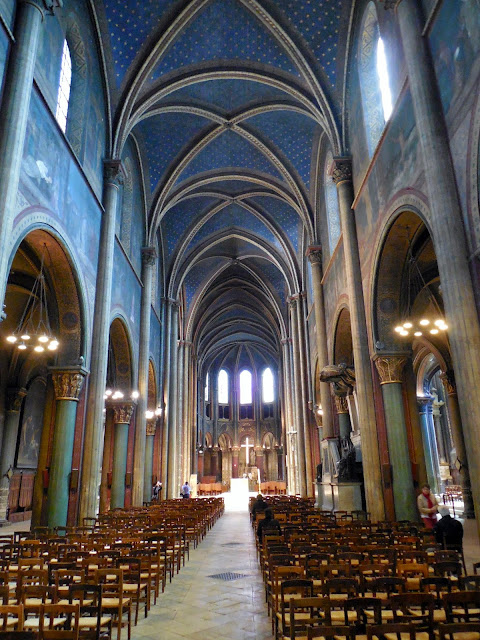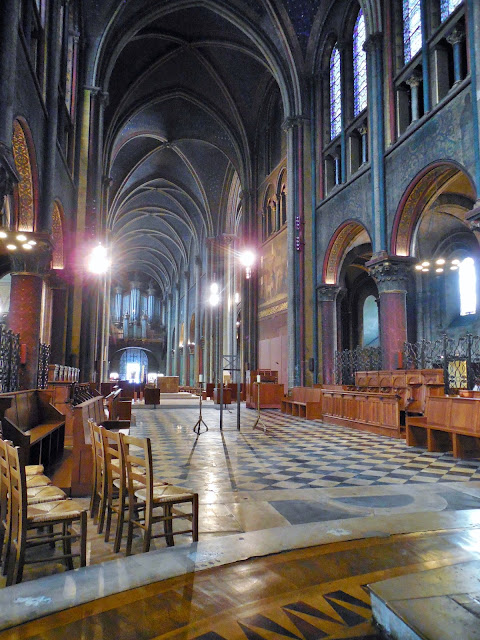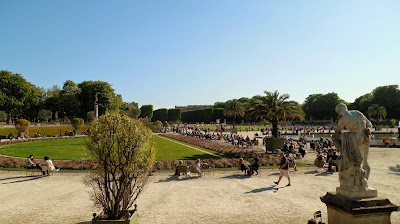which had been a train station built around the turn of the last century, but is now an art museum.
(A view of Sacre Coeur looking through one of the museum's external clocks)
We went through the museum fairly quickly, but made sure we saw works by famous French Impressionists Monet,
and Degas.
After a quick brunch of toast and tea and hot chocolate, we wandered down the Boulevard St. Germain. Along the way, we passed two famous cafes frequented by many famous writers (the Left Bank was a favorite of the arts), including Ernest Hemingway.
"If you are lucky enough to have lived in Paris as a young man, then wherever you go for the rest of your life it stays with you, for Paris is a moveable feast."
-Ernest Hemingway
Saint Germain de Pres had been an abbey, originally founded in the 6th century. The current church was constructed in 1163, and is all that remains of the once influential monastery. Best of all, like St. Chapelle, this cathedral also is painted like it would have been in the middle ages!
We continued on to our next stop, the Cluny Museum, which is located in an old medieval mansion.
This is especially appropriate because the Cluny showcases art from the Moyen Age (Middle Ages).
Below is an interesting exhibit at the museum. These are the heads of the kings, from the original statutes on Notre Dame. During the French Revolution these statutes were beheaded., so the statutes on the cathedral now are recreations.
I am particularly interested in medieval art so this was probably my favorite museum stop, especially because this museum has the famous unicorn and the lady tapestries. This series of 6 tapestries date to the 1500s, and were made in Flanders. Each represents a difference sense.
Touch:
Smell:
Hearing:
Sight:
and the largest, À Mon
There was much more in the museum, including additional tapestries, as well as the mansion's chapel.
In our normal "on the go" style, we just took a little break in a pretty garden across the street from the museum before continuing on our way.
(These pictures were taken in the garden, looking back at the Cluny Museum)
Our next stop was the Panthéon, originally commissioned by King Louis XV to be a church, but was not completed until 1790, around the beginning of the French Revolution. At that time it was determined that the Panthéon would instead commemorate France and her people.
Unfortunately, the building was undergoing major renovation (on the outside and inside), but I did get a couple of pictures of the inside.
Underneath the Panthéon is a necropolis, where many famous French personages are buried (Rousseau, Victor Hugo, Voltaire, and Marie Curie to name a few).
And now, for a quick tea moment! In the Pantheon's gift shop, I picked up my first tea souvenir of the trip, a collection of loose leaf teas in the cutest tins!
Behind the Pantheon was our next stop, Saint-Étienne-du-Mont.
This church was built over a long period of time--1492 to 1626. It had been part of an abbey dedicated to the patron saint of Paris--St. Geneviève. The inside is flamboyant gothic, with some Renaissance influence because of how long it took to complete construction.
(This organ case dates to 1633)
The beautiful carved pulpit was carved in 1651.
One of the most beautiful parts of the church is also the only surviving church structure of its kind in Paris, a jubé, called a rod loft in English. It was carved in the early 16th century. These screens would separate the secular area from the liturgical.
The carvings were simply gorgeous!
From here we walked down to Luxembourg gardens (after stopping for a gelato to take with us, which we ate in the garden).
The gardens were beautiful with the Luxembourg Palace as a backdrop. The palace now serves as the meeting place of France's Senate. We stayed here and relaxed for an hour or so, just like a Parisian.
For this day's nighttime activity we headed to la tour Montparasse (Montparasse Tower) where we took a super fast elevator to the 65th floor. Here we had a dinner of quiche in a café with panoramic views of the city.



































































Great photos (again), especially your pictures from inside Saint-Étienne-du-Mont. I took almost no photos of the inside of that church for some reason, except for the shrine to Saint Genevieve. And the interior was so cool, too-- sheesh, what was I doing??
ReplyDeleteMy favorite things from this day were probably visiting the Cluny Museum and being "green chair people" in the Jardin du Luxembourg! Not necessarily in that order. :-P. Least favorite thing was probably the Pantheon-- too much construction obscuring everything and TOO COLD.
I noticed that you didn't include any of my sneaky pictures from the Musee D'Orsay. ;) :-P
Oh my feet are hurting! It looks like you walked and walked. I need to get a really good pair of shoes. I always do, but they never seem to be enough. I have not been to the shrine or the museum that houses that tapestry. The photos are wonderful, and you saw so much. Thank you for taking us on the tour. xoox Su
ReplyDelete